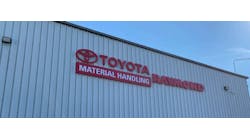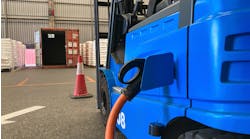| Not all lift trucks are |
When you get right down to it, a lift truck is a commodity — until you need it to go above and beyond the call of duty. Depending on what industry you're in, those duties can be particularly challenging.
- In the retail sector, for instance, lift trucks frequently operate around pedestrians in congested areas. One of the recent trends in this environment has been the adoption of a vehicle speed control that governs the lift truck's travel speed without affecting hydraulic lift and lower performance.
- In the pulp and paper industry, where rolls of paper are commonly transported via railcar, getting those rolls in and out of the railcar without contacting other paper rolls is key. Lift trucks designed with shorter, taller counterweights enable a tighter turning radius for such close-proximity maneuvers and are commonly referred to as “box car special” models.
- In that same industry, where lift truck operators drive in reverse for better visibility due to large loads, lift truck manufacturers are designing vehicles to customers' specific requests, which might include swivel seats and rear-mounted horn buttons to make driving backward more ergonomic.
- Lift truck manufacturers serving the beverage bottling industry have added a “bottler's tilt” feature to their trucks, making it easier for operators to access side-loaded trailers. This added tilt helps get the forks under the load, which is tilted toward the center of the trailer. To enable this, lift truck manufacturers install different tilt cylinders so the vehicle can provide 10-degree forward and five-degree backward tilt (standard operation is five-degree forward and 10-degree backward).
- In food and grocery, where cold and freezer storage is common, lift trucks are protected from condensation with the addition of stainless steel fasteners, tilt cylinders with rubber covers, water-resistant switches and hydraulic systems designed for cold operations.
- In pharmaceutical and food plants, nonmarking tires leave no trace of carbon — which is found in traditional black tires — in these atmospheres. And where quiet office areas are located next to busy manufacturing and distribution operations, lift trucks, at the customer's request, can be equipped with smart backup alarms that automatically adjust their volume to the ambient noise level.
The mistake of thinking of lift trucks as commodities, then, is easy to overcome. Mistakes that result from the misapplication of lift trucks, however, are a bit more costly.
“There are so many instances of end users modifying lift trucks themselves,” says Brett Wood, national product development, strategic planning and marketing manager for Toyota Material Handling USA. “This voids warranties and may, in fact, be dangerous. Any modification needs approval [from the lift truck manufacturer].”
The lift truck manufacturers are more than willing to develop solutions for their customers' unique material handling needs. As an example, Wood cites the time Toyota worked with PPG Industries to jointly design a glass pack handler lift truck.
In PPG's glass factory, large pieces of glass are moved between production and shipping areas. PPG teamed with Toyota and Hydraux to design a solution that puts the lift truck operator on a mast-supported platform from which he can both operate the lift truck and maintain a clear view of the glass being moved.
“If you're controlling this load from the seat of the lift truck you lose a part of your visibility because of the load,” Wood explains. “They've been using this attachment successfully for more than two years.”
Within the food and beverage industry, adding new product lines with multiple SKUs and differing handling requirements can tax the run times of electric lift trucks. Water is a perfect example. Since Nestle USA added bottled water to its product family, lift truck operators have been wrestling with loads in a variety of ways.
Nestle is looking at the AC technology on new electric lift trucks, explains Darrell Elwell, building system super- visor, who is responsible for the company's material handling fleet management. “They seem to have a longer run time. Our next purchase will have those. It will help us with the run time on the battery as well as result in easier maintenance due to brushless motors.”
In the meantime, Nestle has gone to fast charging as another means to increase run time.
The addition of new product lines like drinking water caused this Nestle operation to go from 30% racking to 80%. That meant higher storage and more vehicles — and more battery handling.
“As we added equipment, the battery handling equipment was starting to break down pretty frequently,” Elwell says. “We saw fast charging in the automotive industry and started to pursue it, starting with tests. We ran five trucks on a prototype [supplied by Edison Minit-Charger] for six months. At that point we decided to go with a full retrofit. We have nine chargers with six stations each and two chargers with five.”
This is where the importance of operator training is made clear.
“Our people were used to driving up to a changing station and taking an additional break to wait for a battery change,” Elwell explains. “Fast charging requires more of an effort on the operator's part to keep the lift truck plugged in and charged up. Initially, everybody took breaks at the same time. We discovered we needed to stagger breaks and lunch times so we didn't have everyone in at the same time. Because fast charging is opportunity charging, you put six trucks on a line and each charges about seven to eight minutes, then the system will sequence through and grab the next lift truck at the next lowest state of charge. Now that we stagger the breaks, the operators spread themselves out across the charging stations to create as much opportunity for a charge.”
Elwell says he was able to shave 15% off the costs associated with the old battery changing scenario.
“Fast charging has also reduced our energy consumption,” he concludes. “We went from having 60 chargers out there all plugged in and running at peak times of the day to having 11 chargers, which, while they may be drawing a little more amperage, don't cost as much as the 60 chargers.”
Brian Moll, logistics manager for the Home Depot Store Support Center in Atlanta, says there's a place for both electric and internal combustion (IC) throughout this chain. Home Depot uses fast-charging electric trucks at its 10 import distribution centers (DCs) across the country.
“We wanted to get away from taking batteries out of the trucks,” he explains. “We didn't see any reason why we should be messing around with 2,000- and 3,000-pound batteries. We don't have a maintenance staff and we didn't want a staff devoted to equipment, and we didn't want to assign a staff to changing batteries.”
At the facilities where Home Depot handles bulk goods and lumber, they're running 10,000- to 12,000-pound-capacity IC trucks. Moll, however, decided that its import DCs would do well with 5,000-pound-capacity electric lift trucks.
“We figured, at worst, fast charging would be a break even between not having to purchase extra batteries, not having to devote space to a battery room and not having to staff the room, balanced against the increased cost for the chargers and the electrical work for the fast charge system,” Moll says. “We project more than $100,000 savings per DC, if all the productivity we anticipated is realized. It's easy to show electric bill savings and other hard savings; the soft savings are harder.”
“We've run our lift trucks 16 hours a day five days a week for the last three years,” says Scott Brooks, who oversees sales and purchasing for Jefferson Southern Corp., a Tier 1 supplier to auto- mobile manufacturer Honda. “We've always used liquid propane (LP) gas because we're very tight on space and we don't want to dedicate space to battery management. We like the convenience and cleanliness of the tanks and the gas.”
Jefferson Southern maintains a fleet of 13 Komatsu lift trucks in its 260,000-square-foot plant. Warehousing staff moves heavy loads such as rolled steel from which blanks are cut in preparation to stamp parts.
“That's why we require lift trucks up to 10,000-pound capacity that can also get into narrow spaces to load the blanks into the press machines,” Scott explains. adding that Komatsu streamlined the lift trucks while maintaining their ability to do heavy loading and unloading. “Our press lines are located close to each other, so these vehicles need to maneuver in tight spaces. The lift trucks also run parts to the lines and take completed parts to the service side for staging and shipping to Honda.”
For intermodal operations, industrial lift trucks can help reduce costs during transport and transload processes. Ventura Transfer Co. (VTC), a nonrail port company, loads and unloads heavy intermodal containers and stores them for customers. VTC uses Taylor industrial heavy lift trucks to handle these containers, which weigh up to 60,000 pounds.
These containers can be stored at a savings of 75% per day, compared to traditional fees charged for storing containers while on a chassis or in tank trailer, according to Brian Oken, president and CEO of VTC.
“When you have the capability to lift them off their chassis, thereby freeing the chassis and eliminating daily rental fees, you can reduce costs,” he adds.
Instead of coming in on railcars, requiring transloading and storage, VTC uses its heavy-duty lift trucks to help speed the plant turnaround process by storing its customers' containers at its facilities for later transport and delivery to customer sites. This also saves the costs associated with maintaining large storage tanks, including cleaning and waste disposal.
Combilift, a lift truck manufacturer specializing in markets requiring heavy-duty handling, helps building material dealers maneuver their loads through narrow aisles and doorways. For example, Bison Building Materials uses two 17,300-pound-capacity IC lift trucks from Combilift, one in its Houston facility and another at its facility in Dallas. These multidirectional, all-wheel-drive vehicles, handle long lengths of product between Bison's outdoor, narrow-aisle storage areas through the confines of its production facilities. Two 20-foot-wide doors at each facility provide access.
The trucks are equipped with a quick-disconnect spreader bar and 24-foot-wide forks to handle the 60- to 66-foot lengths of wood without deflection. Multidirectional steering allows the trucks to approach loads perpendicular to their length, but when the wheels are turned 90 degrees, they transport the loads horizontally with maximum maneuverability. The propane-fueled engines allow the vehicles to operate safely indoors. LT
Tom Andel is chief editor of Logistics Today's sister publication Material Handling Management ( www.mhmonline.com ).
Reaching ever higher
A lift truck is only as effective as its operator, and lift truck fleet managers in all industries are spending more time training their people to be safe, knowledgeable and productive. With these new capabilities come new responsibilities to understand how lift trucks will behave in a variety of situations. This will aid the specification process when it's time for new equipment.
“Now customers are looking for more capacity at height,” says James Malvaso, president and CEO of The Raymond Corp. “Replenishment is moving from ABC stocking to right over the pick slot. You want to be able to put 2,500 pounds up at 400 inches and drop it right down to replenish the pick slot. That's why there's high interest in AC and energy utilization. With AC they're running down to 10% to 20% capacity before they have to change the battery. This is because they can run full out without noticing a change in performance. So if they ran through three batteries a shift with DC, with AC they might use two. That's a cost of ownership issue.”
In honoring the request for reaching new heights, lift truck manufacturers must balance several factors, including battery capacity, hydraulic capacity and lifting capacity. That's especially the case in two- and three-shift operations.
When you dedicate orderpickers to rack aisles full time, you must also consider the ergonomic challenges of high-level orderpicking.
“When the truck is used more as an elevator than a transporter, the operator doesn't get as many opportunities to change his body positions,” says Joe Ritter, director of marketing and product management for Crown Equipment Corp. “At higher lift heights your neck, shoulders and back are doing things more continuously than ever, so the lift truck has to address that in the design of the operator compartment.”
resources
Feedback on this article?
© Want to use this article?
Click here for options!
Copyright© 2004 Penton Media, Inc.
at a glance
This article looks at how lift trucks are selected and specified to meet the needs of shippers in several industry sectors.


